Cultural initiatives dedicated to the Rhine – make your cycling trip along EuroVelo 15 unique!
Cyclists tend to love rivers as they provide great views and quite flat banks to cycle on, but the Rhine has much more to offer with its diverse wildlife, its incredible history, and its well-known art romanticism.
It is only logical that a cross-border exhibition series on the Rhine was created to shed light on the famous river in all its dimensions. The museum network gathers museums from France, Germany and Switzerland around a common theme every four years. Therefore, between autumn 2022 and summer 2023, the participating museums are displaying many different thematics and regional approaches around the Rhine. Find more details, including precise addresses and opening hours, on this website, available in German and in French. There is also a brochure available.
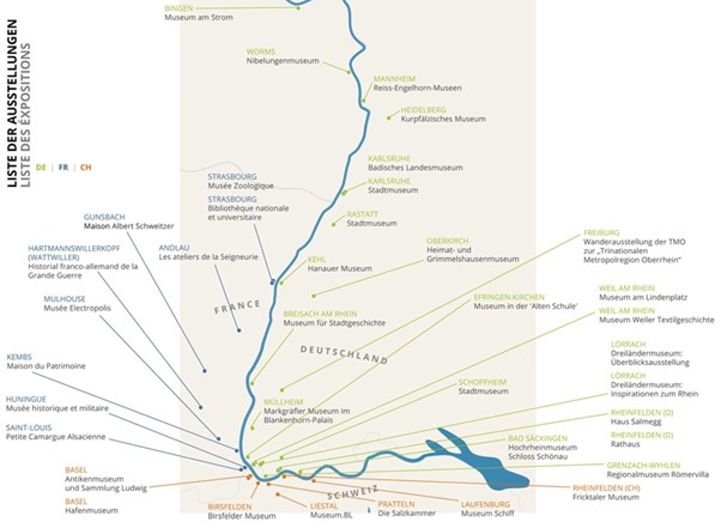
In this article, we present you with a selection of museums, expositions, and projects worth a little detour in all four countries crossed by EuroVelo 15 - Rhine Cycle Route.
Switzerland
The Rhine has its source in the southeastern Swiss Alps, so let us start this cycling and cultural trip from the South to the North Sea.
After spending a few days in the Alps and around Lake Constance, you can stop in Rheinfelden, a town right on EuroVelo 15, to visit your first exhibition at the Fricktal Museum. It describes how life in Rheinfelden is rhythmed by the Rhine with its floodings but also as a leisure space. You will learn stories of fishing, of life along the border of the river, but also how the hydroelectric power plant was built over 100 years ago and supplied the area with electricity.
Only a few kilometres away, make a stop in Pratteln at Die Salzkammer (“the room of salt”) to explore the fascinating history of the "white gold". From 1 May 2023, you can learn how the salt was extracted from the soil on the river’s banks and why the Saline Schweizerhalle was decisive for Basel as a pharmaceutical location. Travel through time by visiting this neo-baroque Villa Glenck dating back from 1860, the former headquarters of the Swiss salt works, and have a glance into an uncovered original drill hole.
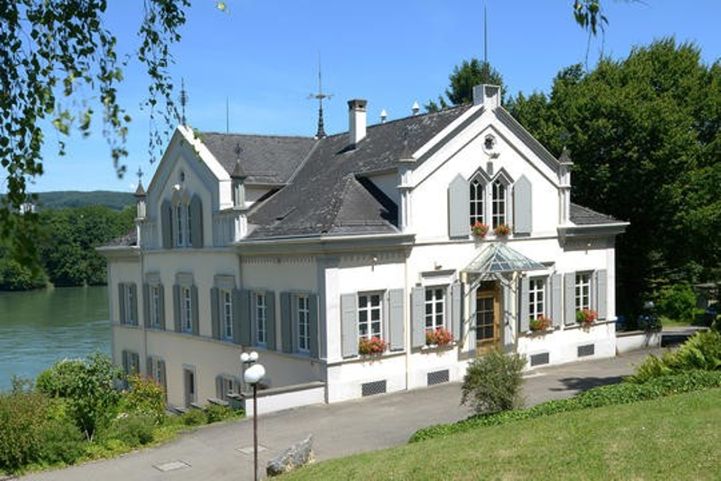
Just before crossing the border, the exhibition “The Rhine and its pastures” at the Hafen Museum (“Harbour Museum”) in Basel can be a good opportunity to discover what a Weidling is, an important means of transport and travel in the Middle Ages (until 30 June 2023). Until the 20th century, the flatboats, built exclusively of wood, were ideally suited to move in the wild Rhine with partly shallow waters. It is still used today in the military, especially due to its stacking capacity, and in water sports.
France
After Basel, the river acts as a natural border between France and Germany until Lauterbourg. Therefore, you can pick the right bank of the Rhine to enter Germany again or cycle on the left side to enjoy the typical Alsaciennes traditions.
Just a few kilometres after Basel, you can head towards Saint Louis at la Petite Camargue Alsacienne to check out the first French exhibition dedicated to the Rhine: “From the wild Rhine to imperial fish farming”. The exhibition offers a journey of discovery about the wild Rhine and its fauna and flora, but also the activities of the people. Visit the historic buildings of the Imperial Fish Farm and learn more about how the salmon was reintroduced in the Rhine, its life cycles and its migration.
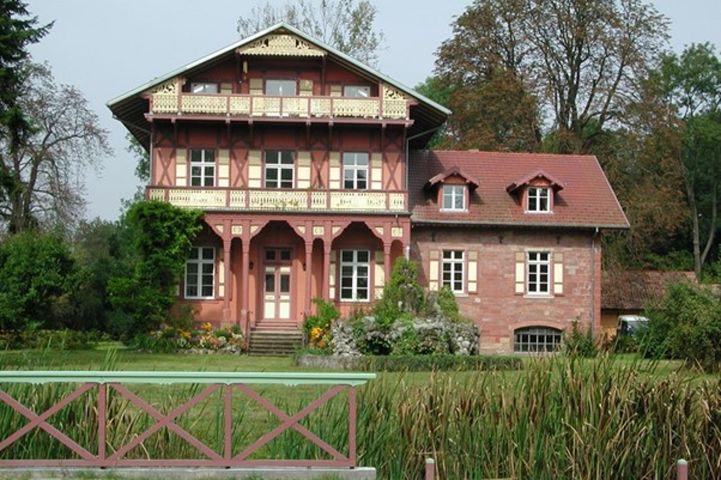
One kilometre away, you will find the Historical and military museum of Huningue with its exhibition telling the story of the unique connection between Vauban and the Rhine. The fortress, built from 1679 on the orders of Louis XIV, served as a military barrier for the newly annexed Alsace to France and was intended to neutralise Rhine bridge from Basel. To this end, the famous architect Vauban used the Rhine to achieve his goals.
From the “Three Countries Bridge” in Huningue you can admire a unique view of three countries in one glance (for pedestrians and cyclists only).
Keep going until Kembs to embark on a journey through the history of the Rhine at la Maison du Patrimoine de Kembs (until 27 September 2023). You will find a chronological tour portraying the Rhine from the 19th century to the present day with paintings, engravings, border maps and old photos. It highlights in particular the construction of the canal, the hydroelectric power station and the dam.
Continue northward until Strasbourg, where you can either switch to the German bank directly (see below) or keep cycling on the same side to explore the full French itinerary. Then, after about 60 km, you arrive at Mothern in the easternmost tip of France. Discover the “Musée de la Wacht” and its permanent exposition “Once upon a time the Rhine”. It harbours a magnificent large wooden model created by Martine Thomas representing the flow of the river from its source to the North Sea. This museum is part of the Rhine Park Pamina, a cross-border ecomuseum on both sides of the Rhine, forming a second network of 14 museums gathered by the common proximity of the Rhine.
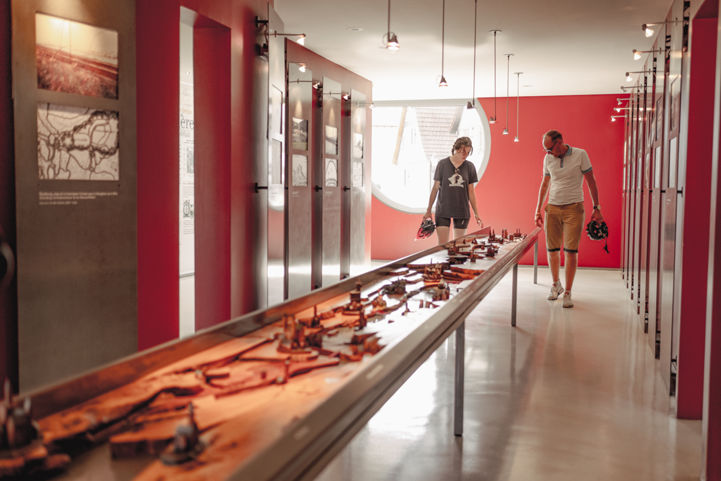
Germany
Going back in time, when arriving in Strasbourg, as mentioned above, you can pick the first choice and cross the river by using the “Brücke der zwei Ufer” (“Bridge of the Two Banks”) to arrive in Kehl, Germany. The Hanau Museum Kehl dedicates its exhibition (available until 27 August 2023) to famous people for whom crossing the Rhine at Kehl changed their life fundamentally, like Marie Antoinette, Caron de Beaumarchais or Sigmund Freud. It also depicts the diverse history of the transitions between Kehl and Strasbourg. Maybe this experience will also strongly impact your life, who knows?
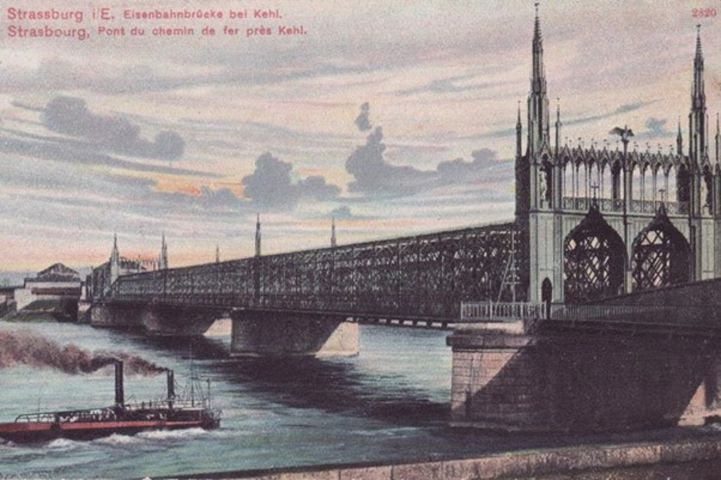
The next stop in the city of Karlsruhe might make you dream even more! If you decided to cycle the whole French section, you will have to cross the river in Wörth to get to Karlsruhe on the “Maxau Rhine Bridges”. The exhibition at the Landes Museum is dedicated to the “Rheingold – raw material from the river”. There are many myths and legends around the so-called Rhine’s treasure. However, these stories did not come out from nowhere as the Rhine carries natural gold like many mountain rivers. It is assumed that people have found ways to retrieve gold from the river since ancient times. For some, gold panning has remained a hobby to this day.
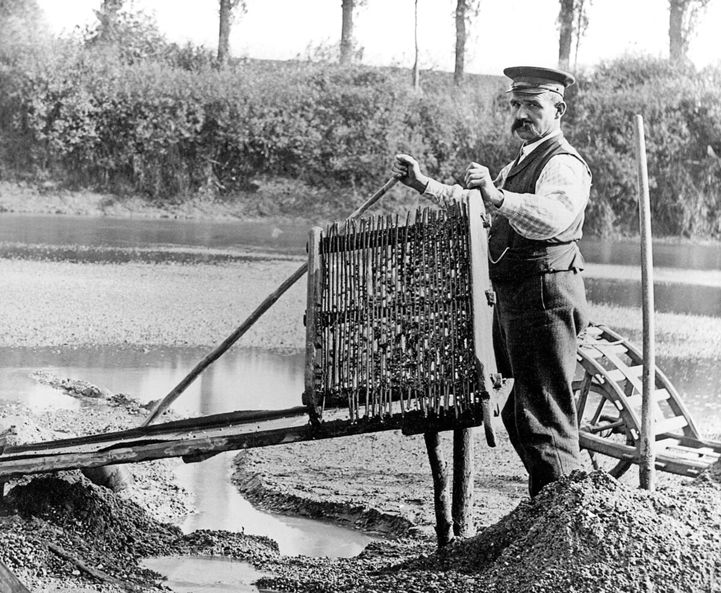
Finally, Bingen and its Museum am Strom offer you the possibility to discover its historical games collection related to the Rhine and learn about important events in German history from the beginning of the 19th century. Don’t miss your chance to immerse yourself in the virtual world of historical travel games.
Two more cycling stages await you from Bingen to Cologne and from Cologne to Arnhem before reaching the Netherlands, another golden opportunity to marvel at the romantic Rhine landscapes.
The Netherlands
In the Netherlands, the Rhine is present in many different shapes – from a main transport route to romantic tributaries and canals, for which the Netherlands are quite famous. It is also where the Rhine empties into the North Sea.
The Biesbosch ('forest of sedges' or 'rushwoods') is a typical example of that. It consists of a network of rivers and smaller and larger creeks with islands. This wetland area is part of a large national park crossed by EuroVelo 15.
The permanent exhibition of the Biesbosch Museum Eiland will teach you the historical development of the Biesbosch and how the freshwater tidal area came into being after the Saint Elisabeth flood of 1421. You will also learn about its inhabitants, their economic activity, their crafts and nature, and you also have the opportunity to try the 'Biesbosch experience', a scale model of the Biesbosch to understand better how it is protecting its surrounding, higher-lying areas from flood. The model is running from April to October. However, in case of prolonged drought, the Biesbosch experience may not work due to a shortage of water.

Another element on your to-do list must be the Inland Navigation Museum of association De Binnenvaart in Dordrecht. It is quite unique as it is aboard the René Siegfried, a decommissioned pusher boat, and it encompasses an inland navigation simulator.
The windmills complex of Kinderdijk (part of UNESCO World Heritage) is a must-see and it is quite important in the history of the region. Two of them are open to the public (the Blokweer Museum Mill and the Nederwaard Museum Mill) and worth a visit.
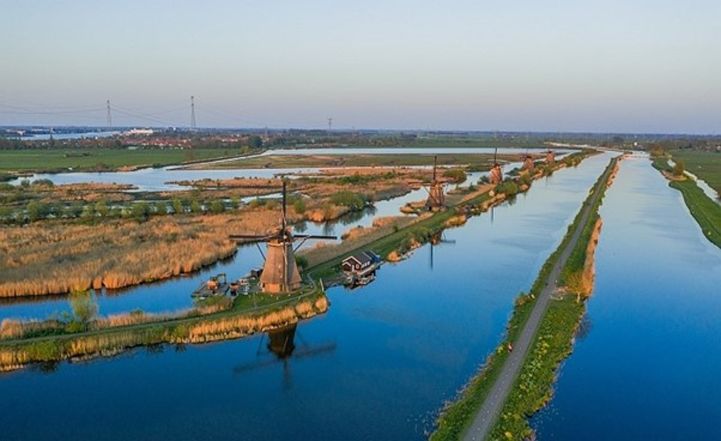
At the end of your cycling trip is the mouth of the Rhine–Meuse–Scheldt delta, Rotterdam, also known as the largest port in Europe, with the rivers Meuse and Rhine providing excellent access to the hinterland upstream.
Its Maritime Museum, located in the old port area, has a distinctive design in the shape of a large ship that will make you feel like a sailor while using the iron ladders to reach the top of the deck. The museum displays ship models, navigation maps and various instruments from the 15th century to the present, and even abandoned Rhine cruise ships.
To conclude, EuroVelo 15 has a lot to offer in addition to its incredible cycling experience! If you still need a little push to be convinced, read Ben Coate’s inspiring interview and scroll through EuroVelo’s Instagram page to marvel at the wonderful pictures of EuroVelo 15 taken in the frame of the EuroVelo Summer Photo Contest.
The contest is running each year in July and August for both Rhine Cycle Route and EuroVelo 19 - Meuse Cycle Route. So, start planning and hop on your bike with your camera to win a cycling tour on the Meuse Cycle Route.
More about how to participate in the contest, and other relevant information are available on this link.
Author: Alexandra Fournier
Cover picture: Breisach ©European Cyclists’ Federation, Demarrage LTMA, P. Gawandtka